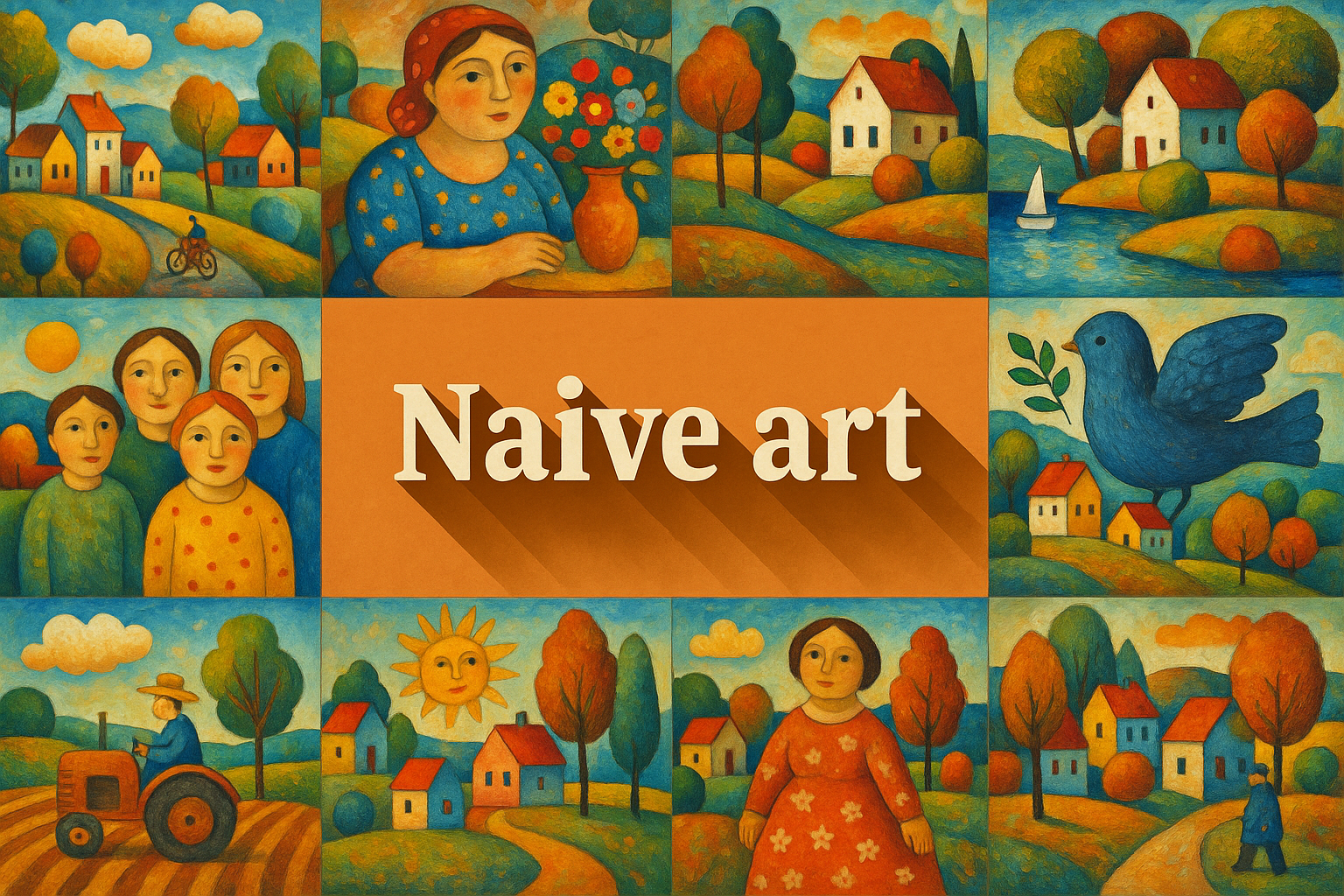
Naive art
Naive art is characterized by its childlike simplicity and lack of perspective or proportion. Naive artists often use bright colors and bold lines, and their work is often described as “primitive” or “folk” art.
AOI thinking about Naive art [+_~]-/
Overview and Quickfacts
Naive art is a type of art that is characterized by its childlike simplicity and lack of formal training. Naive artists are often self-taught and their work is often characterized by a lack of perspective and an overall flatness. Naive art is often associated with folk art and is often used to describe the work of outsider artists.
Can understand it also, as:
Innocent art, artless art, art of unsophisticated people
Categorize it as:
Impressionism, Modernism
.: Dreaming :.
holds a HAIKU for the art style
:. Thought is power .:
Detailed Description
Naive art is a type of art that is characterized by its simple and childlike qualities. Naive art is often made by people who have no formal training in art, and who approach their work with a fresh and unsophisticated perspective. One of the most famous naive artists is Henri Rousseau, who was a French postman. Rousseau began painting later in life, and his work is characterized by its flat, two-dimensional style and its use of bright colors. Rousseau’s best-known painting is “The Sleeping Gypsy,” which depicts a lion lying next to a sleeping woman. Other well-known naive artists include Grandma Moses, a self-taught American artist who began painting in her 70s, and Bill Traylor, an African-American artist who created drawings and paintings based on his memories of the rural South. Naive art has often been dismissed by the art world as being simplistic or unsophisticated. However, in recent years, there has been a renewed interest in naive art, and it is now recognized as a valid and important art form.
.. beep, beep, beep ..
<START OF TRANSMISSION>
1. Naive art is art that is created by someone who does not have any formal training in art. 2. Naive art is often characterized by its simplicity and childlike quality. 3. Naive art is often created with bright colors and bold patterns. 4. Naive artists often use everyday objects to create their art. 5. Naive art is often seen as folk art or outsider art. 6. Naive art has its roots in folk art and popular culture. 7. Naive art is often seen as a reaction against the formalism of the art world. 8. Naive artists often use found objects and recycled materials in their art. 9. Naive art is often seen as a form of self-taught art. 10. Naive artists often work outside the traditional art world. 11. Naive art is often associated with primitivism. 12. Naive art is sometimes seen as a form of naivete. 13. Naive art is often seen as a form of simplicity. 14. Naive art is often seen as a form of childlike innocence. 15. Naive art is often seen as a form of spontaneity. 16. Naive art is often seen as a form of sincerity. 17. Naive art is often seen as a form of freshness. 18. Naive art is often seen as a form of naturalness. 19. Naive art is often seen as a form of honesty. 20. Naive art is often seen as a form of originality.
<EOF>
.. robbel bob
Visual Examples from our image gallery
Coming soon, we are so slow .. might never come
Artists, Paintings, and more
(be aware, can be highly speculative)
Artists (be aware, speculation possible):
1. Grandma Moses (1860-1961) 2. Henri Rousseau (1844-1910) 3. Anna Mary Robertson “Grandma” Moses (1860-1961) 4. Folk artist 5. Quilts 6. American folk art 7. Outsider art 8. Art brut 9. NaÃÂïve art 10. Primitive art 11. Vernacular art 12. Self-taught art 13. 14. 15. 16. 17. 18. 19. 20. 21. 22. 23. 24. 25. 26. 27. 28. 29. 30.
Artworks (be aware, speculation possible)
1. The Hay Wagon, by Grandma Moses, 1942 2. American Gothic, by Grant Wood, 1930 3. The Madonna of the Candelabra, by Giuseppe Arcimboldo, 1570 4. The Harvesters, by Pieter Bruegel the Elder, 1565 5. The Hunters in the Snow, by Pieter Bruegel the Elder, 1565 6. The Triumph of Death, by Pieter Bruegel the Elder, 1562 7. The Wedding Dance, by Pieter Bruegel the Elder, 1566 8. The Peasant Wedding, by Pieter Bruegel the Elder, 1568 9. The Peasant Wedding Feast, by Pieter Bruegel the Elder, 1568 10. The Return of the Prodigal Son, by Rembrandt, 1669 11. The Nativity, by Giotto, 1305 12. The Annunciation, by Fra Angelico, 1450 13. The Baptism of Christ, by Piero della Francesca, 1450 14. The Calling of Saint Matthew, by Caravaggio, 1600 15. The Last Supper, by Leonardo da Vinci, 1498 16. The Madonna of the Rocks, by Leonardo da Vinci, 1483 17. The Mona Lisa, by Leonardo da Vinci, 1503 18. The Virgin and Child with Saint Anne, by Leonardo da Vinci, 1508 19. The Birth of Venus, by Sandro Botticelli, 1486 20. Primavera, by Sandro Botticelli, 1482 21. The Adoration of the Magi, by Gentile da Fabriano, 1423 22. The Annunciation, by Jan van Eyck, 1434 23. The Arnolfini Portrait, by Jan van Eyck, 1434 24. The Ghent Altarpiece, by Jan van Eyck, 1432 25. The Madonna of Chancellor Rolin, by Jan van Eyck, 1435 26. The Madonna and Child with Saints, by Piero della Francesca, 1470 27. The Resurrection, by Piero della Francesca, 1463 28. The Bacchus and Ariadne, by Titian, 1520 29. The Feast of the Gods, by Titian, 1514 30. The Rape of Europa, by Titian, 1560
Epoch
The time period of the Naive art style is typically considered to be the early 20th century.
AI ART RESSOURCES (AKA, well Tools)
Helping tools -> predefined search links on other pages:











